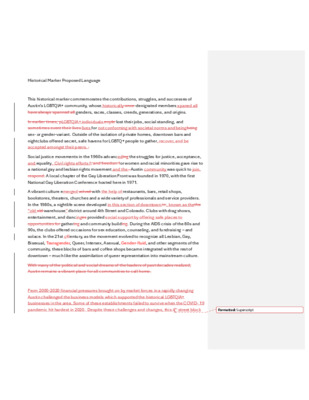Backup — original pdf
Backup

Historical Marker Proposed Language This historical marker commemorates the contributions, struggles, and successes of Austin’s LGBTQIA+ community, whose historically once-denigrated members spaned all have always spanned all genders, races, classes, creeds, generations, and origins. In earlier times, pLGBTQIA+ individuals eople lost their jobs, social standing, and sometimes event their lives lives for not conforming with societal norms and beingbeing sex- or gender-variant. Outside of the isolation of private homes, downtown bars and nightclubs o(cid:431)ered secret, safe havens for LGBTQ+ people to gather, recover, and be accepted amongst their peers. . Social justice movements in the 1960s advanceding the struggles for justice, acceptance, and equality. Civil rights e(cid:431)orts f, and freedom for women and racial minorities gave rise to a national gay and lesbian rights movement and the . Austin community was quick to join. respond. A local chapter of the Gay Liberation Front was founded in 1970, with the first National Gay Liberation Conference hosted here in 1971. A vibrant culture emerged volved with the help of restaurants, bars, retail shops, bookstores, theaters, churches and a wide variety of professionals and service providers. In the 1980s, a nightlife scene developed in this section of downtown in , known as thethe “old old warehouse” district around 4th Street and Colorado. Clubs with drag shows, entertainment, and dancinges provided social support by o(cid:431)ering safe places to opportunities for gathering and community building. During the AIDS crisis of the 80s and 90s, the clubs o(cid:431)ered occasions for sex education, counseling, and fundraising – and solace. In the 21st cCentury, as the movement evolved to recognize all Lesbian, Gay, Bisexual, Transgender, Queer, Intersex, Asexual, Gender-fluid, and other segments of the community, these blocks of bars and co(cid:431)ee shops became integrated with the rest of downtown – much like the assimilation of queer representation into mainstream culture. With many of the political and social dreams of the leaders of past decades realized, Austin remains a vibrant place for all communities to call home. From 2000-2020 financial pressures brought on by market forces in a rapidly changing Austin challenged the business models which supported the historical LGBTQIA+ businesses in the area. Some of these establishments failed to survive when the COVID- 19 pandemic hit hardest in 2020. Despite these challenges and changes, this 4th street block Formatted: Superscript and the buildings on it, continue to represent Austin’s LGBTQIA+ community’s historical and future perseverance and identity.